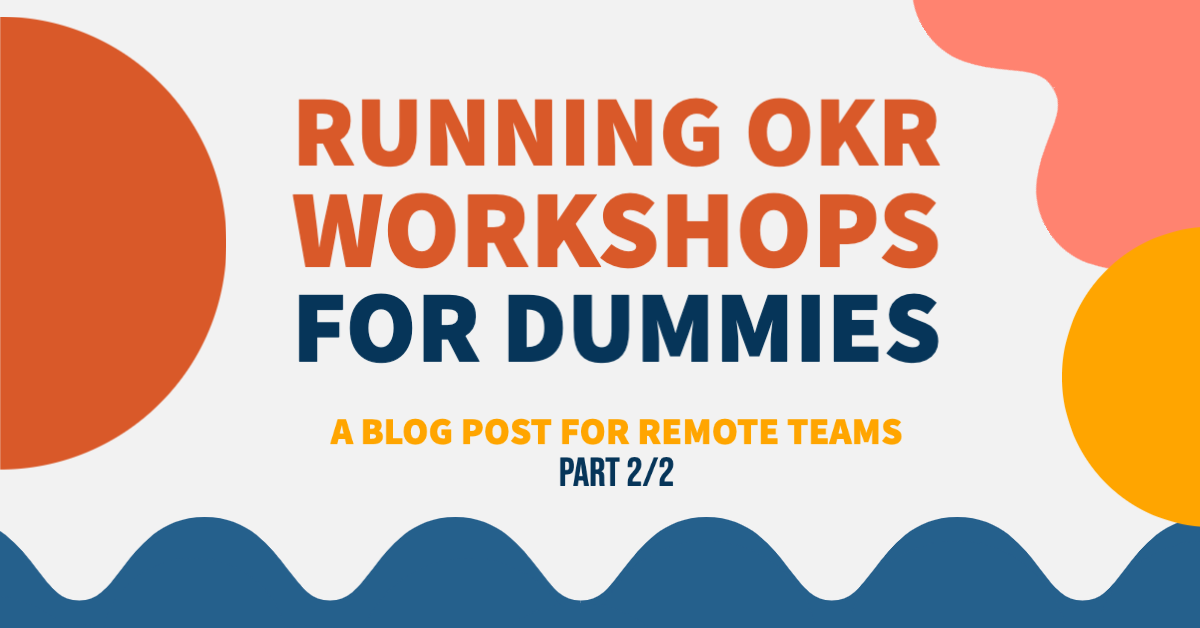In part 1, we discussed how to plan and execute the first parts of setting your OKRs.
In this post, we’ll discuss narrowing down the list of success metrics, finalizing them and establishing baselines, and finally sharing them with your stakeholders.

By now, you should have an extensive list of objectives with some metrics, both good and bad ones.
Now, you can brainstorm!
Session 3: Brainstorm on measuring success
In this session, consider the grand outcomes and outputs that you highlighted in the previous session.
You still want to brainstorm, but this brainstorm should be guided. You can start with the “obvious” – because sometimes an outcome can be a success measure by itself. For example, if you want the outcome to be increased retention, a measure of that may be “reduce churn by X%” – that is a measure of success.
You will still want to augment it though:
- Bad: “Reduce e-mail bounce rates” – this is a vanity metric, it doesn’t display any kind of real outcome.
- Bad: “Reduce churn by X users” – this is still bad because if you experience sudden growth, 20 may not be indicative anymore – but we’re getting closer.
- OK: “Reduce churn by Y% of users” – this is better. It is relative and less swayed by external factors.
- Good: “Reduce churn by Y% of users by Q3” – this is best because it is also time-limited.
For some more complex outcomes – the success measure may not be as obvious. For example, when working on internal projects, the desired success metrics may be quite soft and fluffy, but you can still try them out!
With less clear outcomes, you may want to come up with lots of candidates – a combination of which will point to success. For that matter, a survey or NPS of your tooling may be part of establishing success together with the time-to-start, number of users using a tool, number of support tickets, etc.
Whichever route you choose, make sure you have lots of metrics to play around with!
Offline: Narrow down the list of success metrics
After the session, sit down with yourself and try to evaluate which metrics you can measure. You may not be able to measure everything right now, but it may be worth investing some of your team’s efforts on getting some of the data needed.
If you spend half of your time counting support tickets – you are doing something wrong. However, if you can get even a rough estimate with an easy-to-run SQL query – that’s a lot better!
Session 4: Finalise the metrics and establish the baselines
Now that you have a narrowed down list of success metrics, come back to your team for one final round to establish the baselines and work out the exact wording.
Don’t cut corners so close to the finish line! It’s important to do this with the team, so that they feel connected to these metrics!
Together, replace the placeholder values in the metrics (e.g., X users, Y% companies, within Z days, etc.) with achievable but ambitious numbers.
I can’t really tell you how to do this, because this is super-dependant on your field and your expertise. Good luck!
Offline: Officially share the OKRs with your stakeholders
It is time to assemble a Notion page, short presentation, or even a one-pager to share with your stakeholders.
Make sure the stakeholders can add comments, but you may not want to let them edit the page entirely.
Sure, you kept them up-to-date in the previous parts of the process, but this is their chance to weigh in.
If you have good stakeholders, they’ll ask lots of questions and ask to explain how you’ve reached the numbers. Since the team worked on it together, you should be able to stand by those numbers.
I suggest you avoid the temptation to change them by an order of magnitude, but consider if they have been ambitious enough. If your business goal is to reduce churn by 10%, maybe a more ambitious 12% would be better? If you reach it – everyone will be delighted, especially the person who asked about it.
This is the last opportunity to revise and refresh everything if you have to. If your stakeholders didn’t understand the wording – now’s your chance to improve it!
Avoid running more sessions unless absolutely necessary!
Finalise the OKRs and share them with the world
We’ve reached the end! That’s it! You’ve successfully braved the OKR workshops.
You and your team now have OKRs that you can be proud of, hopefully.
Share them with the world!
Talk about them often, internally and externally.
Feature them in planning / retro sessions (if you use Notion, consider synced blocks!)
Update your team (and select stakeholders) on your progress!

Leave a Reply